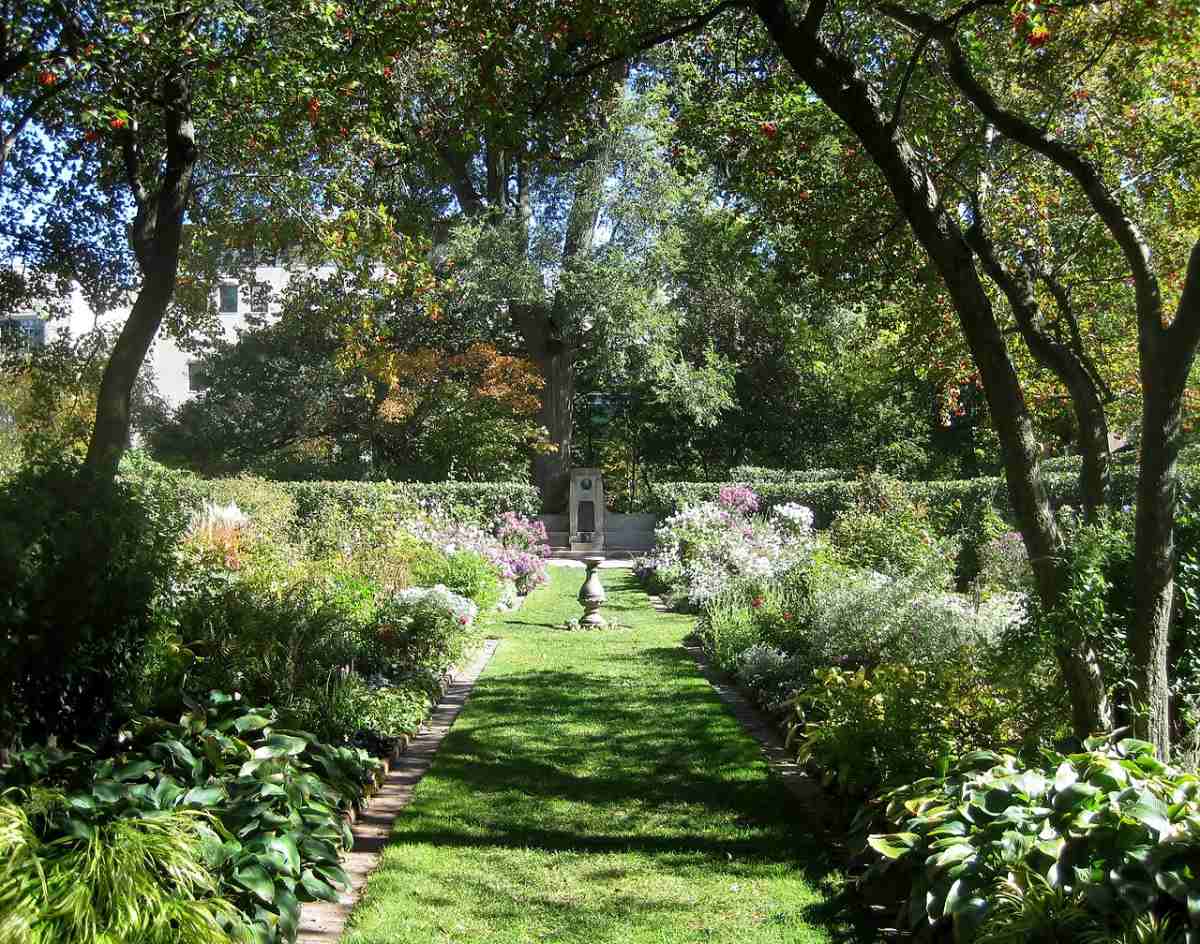
Illinois boasts a wide variety of native flora, but sadly, its indigenous blossoms are under threat from invasive foreign species. Among these natural treasures, native Illinois flowers are a sight to behold and crucial for maintaining the state’s natural ecosystem balance.
Planting native plants not only spruces up our yards but also aids crucial pollinators. It’s an eco-smart way to protect nature and reduce chemical use. Beautiful and praiseworthy, native Illinois plants add an air of homegrown charm to any landscape. So, let’s take a moment to explore some of the native blooms that would look great in your Illinois garden.
- Wild Bergamot (Monarda fistulosa)
- Pale Purple Coneflower (Echinacea pallida)
- Eastern Red Columbine (Aquilegia canadensis)
- Stiff Goldenrod (Oligoneuron rigidum)
- New England Aster (Symphyotrichum novae-angliae)
- Common Milkweed (Asclepias syriaca)
- Jack in the Pulpit (Arisaema triphyllum)
- Wild Quinine (Parthenium integrifolium)
- Wild Geranium (Geranium maculatum)
- Compass plant (Silphium laciniatum)
- FAQ
Wild Bergamot (Monarda fistulosa)
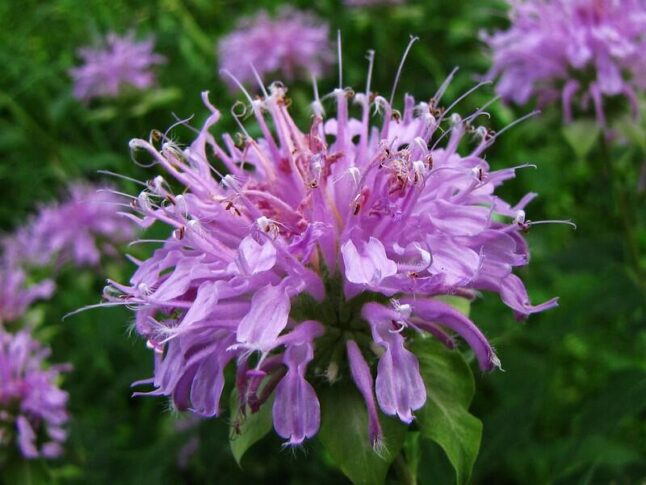
Wild bergamot is a showy perennial plant native to North America. A member of the mint family, this hardy plant is not only drought-resistant but also a favorite among wildlife, drawing in bees, butterflies, and hummingbirds alike.
Though it’s pretty adaptable, thriving in a range of soils and light conditions, it really comes into its own in well-drained soil and under the full blaze of the sun. Wild bergamot can shoot up to four inches in height and sports gorgeous purple flowers from the middle of June right through to the beginning of September.
Beware, though, as it tends to take over its surroundings, spreading rapidly via its rhizomes. Don’t fret – wild bergamot can be kept in check by simply yanking out any unwanted seedlings.
Pro tips:
- Maximize growth and blooms by planting in full sun.
- To prevent aggressive spreading, plant it where there is competition from other plants.
Main Characteristics:
- USDA Hardiness zones: 4a – 9a
- Duration: Perennial
- Sun: Full sun, partial shade
- Soil: Sandy, loam, clay; it prefers well-drained soil
- Height: 2-4 inches
- Maintenance: Low; water during dry spells, don’t fertilize, and plant in well-ventilated areas to avoid powdery mildew. Remove spent flowers for more blooms.
- Attracts: Butterflies, Hummingbirds, Pollinators
- Tolerance: Drought, heat, humidity, rabbits
Where to find wild bergamot:
- TKE Farms – Wild Bergamot
- Wild Bergamot Bee Balm Seeds for Planting (Monarda fistulosa)
- Outsidepride Wild Bergamot Monarda Fistulosa Mintleaf Bee Balm Herb
- Ounce Dried Flower Petals Wild Bergamot
Pale Purple Coneflower (Echinacea pallida)
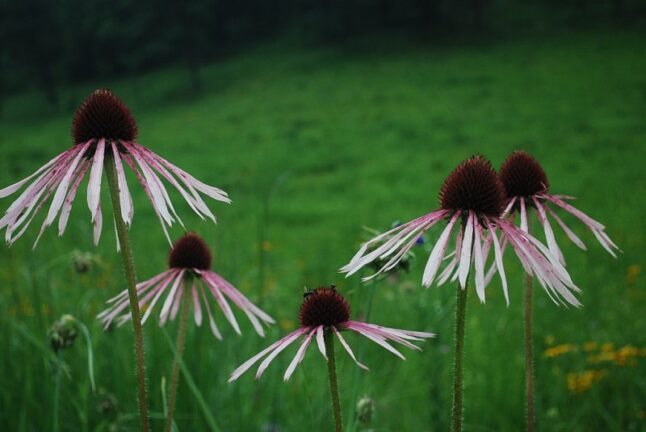
The pale purple coneflower is a vibrant perennial found in many Chicago region gardens. It blooms with beautiful purple daisy-like flowers from the middle of summer until fall, providing a pop of color throughout the season. Its spiny, dark brown central cone will draw birds to feast on the seeds come wintertime.
It’s a low-maintenance, sunny little beauty. It can tolerate various conditions, from dry to medium moisture soils and heat with humidity. Plus, don’t be deterred by pest or disease issues – purple coneflower is surprisingly resistant to many of these, and deer, as well.
Pro tips:
- To get the most out of this charming native flower, place it in an area with full sun exposure and let the good times bloom.
- Make sure to deadhead spent blossoms as well as cut back stems every now and then for even more blooms.
- You can propagate it via seeds, division, or root cuttings.
- You can brew the flowering heads into a tea that’s said to give your immune system a bit of a lift.
Main Characteristics:
- USDA Hardiness Zones: 3-9
- Duration: Perennial
- Sun: Full sun, partial shade
- Soil: Average, dry to medium moisture, well-drained; loam, chalk, sand
- Height: 2 – 5 ft.
- Maintenance: Low; deadhead spent flowers and cut back stems to promote further blooming
- Attracts: Butterflies, Hummingbirds, Pollinators
- Tolerance: Drought, heat, and humidity; Deer
Where to find pale purple coneflower:
Eastern Red Columbine (Aquilegia canadensis)
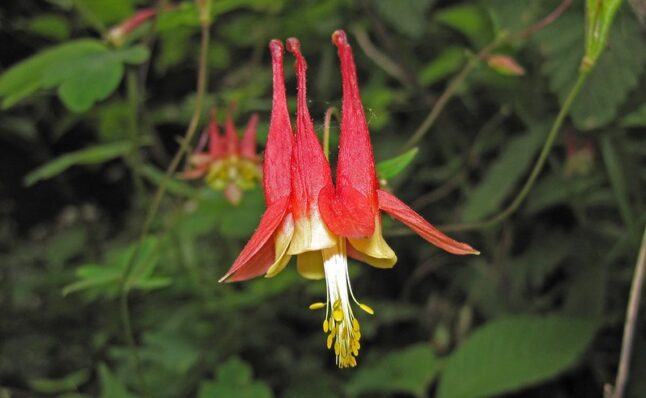
Nothing says summer quite like the deep red and yellow bell-shaped petals of eastern red columbine, also known as American columbine or Canadian columbine. This enchanting native wildflower is a must for any garden. Blooming from late spring through early summer, its long-lasting nectar provides an irresistible lure to hummingbirds and other pollinators.
Though not particularly fussy about its soil type, eastern red columbine sprouts best in average, moist, well-drained soil with some shade. Too much sun and rich soil can reduce the plant’s lifespan. Likewise, sandy soils create a shorter but denser plant. Moreover, Columbine plants are quite resilient and have a knack for self-seeding.
Pro tips:
- For maximal growth and bloom, plant in full sun.
- To control its spread, plant it near other plants.
- Seeds may be sown directly in the garden in spring after frost danger has passed (and can also be divided).
- Remove dead flower stems to encourage more blooms and nip back foliage when it fades.
Main Characteristics:
- USDA Hardiness Zones: 3-8
- Duration: Perennial/self-seeds
- Sun: Full sun to part shade
- Soil: Well-drained; moist but not water-logged; clay, loam, sand
- Height: 3 ft.
- Maintenance: Low; deadhead spent flowers for more blooms, cut back when foliage fades.
- Attracts: Hummingbirds and butterflies
- Tolerance: Good resistance to disease, shade, dry soil, and deer
Where to find eastern red columbine:
- Canadian Columbine Seeds Eastern Red Columbine
- CHUXAY GARDEN Aquilegia Canadensis Seed 50 Seeds Canadian Columbine Flowers
- CHUXAY GARDEN Aquilegia Canadensis Seed 200 Seeds Beauty Canadian Columbine Flowers
Stiff Goldenrod (Oligoneuron rigidum)
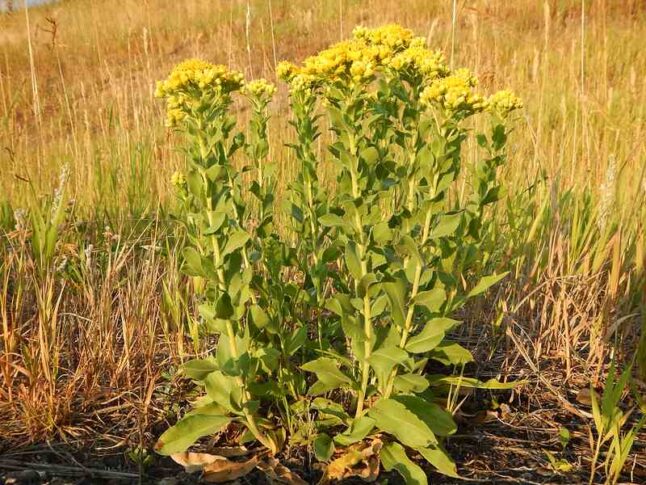
The stiff goldenrod is a burst of sunshine for any garden. As summer fades into autumn, this hardy perennial stands tall and unbranched, lighting up the space with its clusters of bright yellow flowers.
Although it thrives in dry, poor soils, it can tolerate a range of conditions, making it a fantastic addition to cottage gardens. Additionally, its broad leaves transform from a soft gray-green to vibrant shades of orange as the season progresses.
Pro tips:
- It does best in full sun and soil that has medium to dry moisture and is well-drained.
- You can propagate it by seed or division in the spring or fall.
- Cut back the spent flower stems and divide the plant every two to three years to keep it from getting too large.
Main Characteristics:
- USDA Hardiness Zones: 3-9
- Duration: Perennial
- Sun: Full sun
- Soil: Well-drained; moist but not water-logged; clay, loam, sand
- Height: 1-5 ft.
- Maintenance: Low; cut back the spent flower stems
- Attracts: Butterflies, birds, bees
- Tolerance: Good disease resistance, deer, dry and clayey soil
Where to find stiff goldenrod:
- 1000 Seeds of Oligoneuron rigidum, Stiff Goldenrod
- Stiff Goldenrod Seeds for Planting
- 1 oz Seeds (Approx 41000 Seeds) of Oligoneuron rigidum, Stiff Goldenrod
New England Aster (Symphyotrichum novae-angliae)
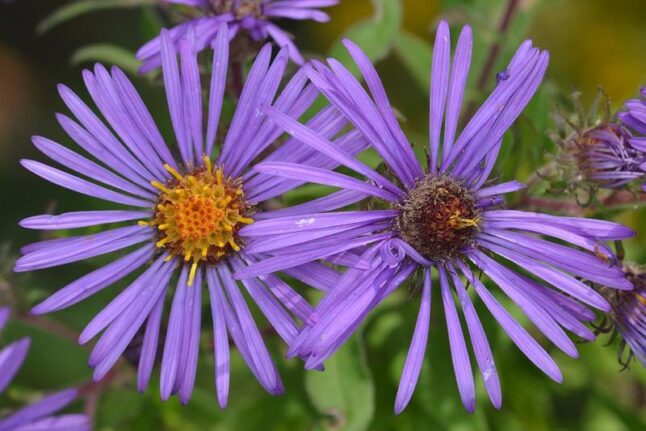
Bursting forth with deep purple petals and sunny yellow centers, these beauties steal the spotlight from late summer to early fall. They boast upright stems covered in fine hairs with a whole bunch of leaves shaped like lances.
Doing a real solid for the insect world, New England aster is like a gas station for butterflies, especially Monarchs. New England aster loves full sun but can tolerate light shade, and it’s quite adaptable to a range of soil types, though it does best in moist, well-drained soils.
Oh, and a little heads up – it can get pretty tall, sometimes reaching up to 6 feet in height, so be sure to give it plenty of space to flourish.
Pro tips:
- To encourage bushier growth and more flowers, pinch the tips of the stems back in early summer.
- Divide the plants every 2-3 years in the spring to maintain vigor and prevent overcrowding.
- Plant it in groups or masses for a stunning visual impact and to attract more pollinators.
Main Characteristics:
- USDA Hardiness Zones: 4-8
- Duration: Herbaceous, perennial
- Sun: Full sun
- Soil: Well-drained; moist but not water-logged; clay, loam, sandy
- Height: 3-6 ft.
- Maintenance: Moderate; pinch back tips for bushier growth, divide every 2-3 years
- Attracts: Butterflies, birds, bees
- Tolerance: Good disease resistance, deer, rabbits, clay soil
Where to find New England aster:
- CHUXAY GARDEN Pink Symphyotrichum Novae-angliae,New England Aster
- 500 Seeds of Symphyotrichum novae-angliae, New England Aster
- Symphyotrichum novae-angliae | New England Hardy Aster
Common Milkweed (Asclepias syriaca)
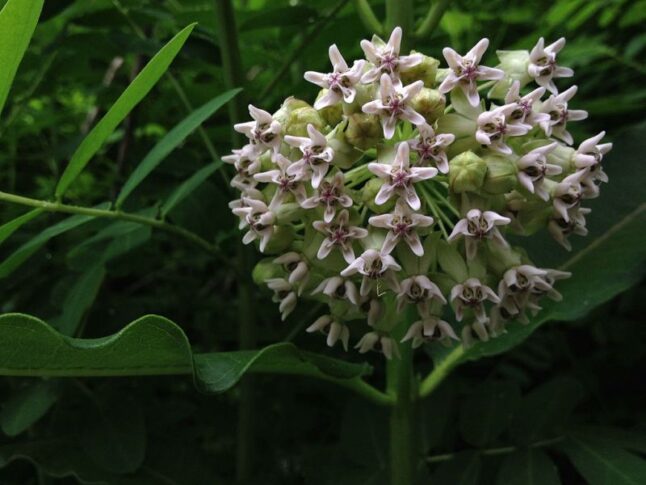
Milkweeds are critical for the survival of monarch butterflies, and the common milkweed is no exception. Asclepias syriaca, a perennial native to Illinois, produces lovely clusters of fragrant, pinkish-purple flowers that attract a variety of pollinators from mid to late summer. Its leaves serve as the primary food source for monarch caterpillars.
Common milkweed is pretty easygoing when it comes to soil – it’ll grow in a bunch of different types. But give it a well-drained soil, and it’s like putting it in its happy place. This is where it really shines.
It can grow up to 3 feet tall and tends to spread aggressively via underground rhizomes, so it’s best planted in areas where it can roam freely.
Pro tips:
- Plant milkweed in groups to attract more monarchs. Fall is the recommended time for sowing seeds.
- Be careful not to overwater; it prefers drier soil.
- If you want to control its spread, remove the seed pods before they open.
- It thrives in natural spots like open fields, meadows, and butterfly gardens.
- Common milkweed is toxic and irritating to skin and eyes, making it a risky choice if you have kids or pets. Consider planting it out of reach or opting for a different plant.
Main Characteristics:
- USDA Hardiness Zones: 3-9
- Duration: Perennial
- Sun: Full sun to light shade
- Soil: Moist, well-drained; clay, loam, sandy soils
- Height: 3-4 ft.
- Maintenance: Low; water during dry spells
- Attracts: Butterflies, especially Monarchs, and bees
- Tolerance: Drought, dry soil, deer
Milkweeds are a must-have for monarch butterflies, and planting them can help save this endangered species. The U.S. is home to over 100 native species, but if you’re in Illinois, besides the Common Milkweed, there are a handful of others that will thrive, including:
- Butterfly weed (Asclepias tuberosa): Light orange flowers.
- Swamp milkweed (Asclepias incarnata): Mauve, pink, or white flowers.
Where to find common milkweed:
- Common Milkweed Native Seeds (Asclepias Syriaca)
- Common Milkweed Seeds
- Common Milkweed Seed Balls for Fall Planting (Asclepias syriaca)
Jack in the Pulpit (Arisaema triphyllum)
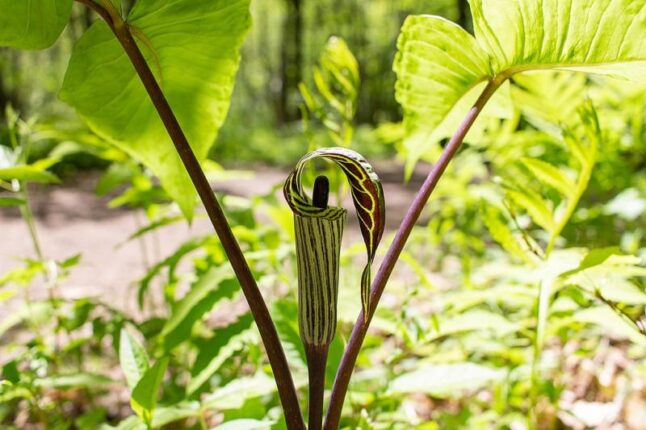
The Jack in the pulpit is a peculiar and fascinating plant that’s native to the northern US, including Illinois. This woodland perennial has an unusual, hood-like structure called a spathe, which surrounds a spike called a spadix – and this is where the ‘Jack’ and ‘pulpit’ bit of the name comes into play.
It typically blooms from April to June, displaying its unique, greenish-purple flower. In the summer, it produces clusters of bright red berries, which can add a pop of color to your garden. Be careful, though, as all parts of this plant are toxic when ingested.
While it can tolerate a range of soil types, it prefers rich, moist, well-drained soils. Additionally, Jack in the pulpit prefers full shade but can tolerate moderate shade as well.
Pro tips:
- Water regularly to keep the soil moist.
- Plant it in a shaded area of your garden to mimic its natural woodland habitat.
- Jack in the pulpit doesn’t require a lot of maintenance, but you can remove dead foliage as necessary to keep it looking neat.
Here’s a quirky fact for you: Jack in the pulpit has a fascinating party trick up its sleeve. It can switch its sex from one year to the next! Initially, it only sports male flowers on its spadix, but then, out of the blue, it transforms into a female the following year, and it keeps flip-flopping like that. Nature sure has its wonders, doesn’t it?
Main Characteristics:
- USDA Hardiness Zones: 4-9
- Duration: Perennial; spreads through bulbs
- Sun: Full to moderate shade
- Soil: Rich, moist, well-drained; loam, sand
- Height: 1-2 ft.
- Maintenance: Moderate; Mulch it in the fall months
- Attracts: Minimal wildlife attraction due to toxicity, typically birds
- Tolerance: Wet soil, heavy shade, deer
Where to find Jack in the pulpit:
- 5 Jack in The Pulpit Arisaema Triphyllum Shade Flower Seeds
- 5 Jack in The Pulpit Arisaema Triphyllum Shade Flower (LSL) Seeds*Flat Shipping
- Jack in Pulpit Bulbs Arisaema triphyllum 10 Bare Roots
Wild Quinine (Parthenium integrifolium)
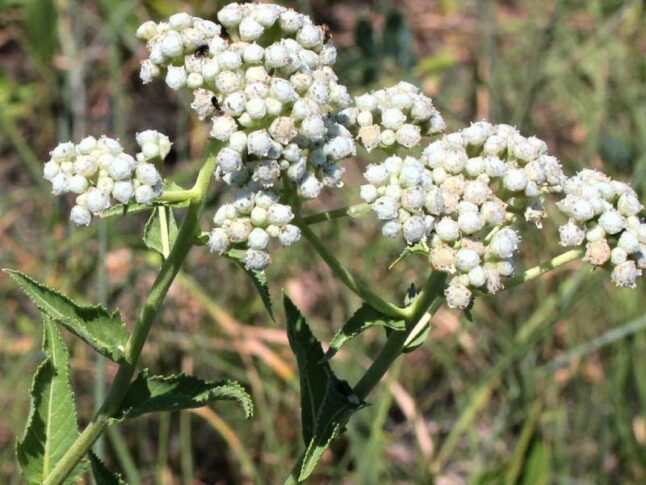
The wild quinine is a perennial that showcases flat-topped clusters of small, white flowers from late spring to early fall.
It also has these medium-green, gritty leaves that look like they’ve got teeth along the edges. They’re big and broad, forming a sort of leafy circle at the base – a sturdy stalk sprouts from the middle, dotted with smaller leaves.
Quinine is a strong and sturdy plant that can handle drought and doesn’t require much in the way of maintenance.
Pro tips:
- It’s drought-tolerant once established, so you won’t need to water it.
- You can propagate it by seed or division.
Main Characteristics:
- USDA Hardiness Zones: 4-8
- Duration: Perennial
- Sun: Full sun to partial shade
- Soil: Well-drained; loam, sand, clay
- Height: 2-4 ft.
- Maintenance: Low; remove spent flowers
- Attracts: Butterflies, bees
- Tolerance: Drought
Where to find wild quinine:
- Parthenium integrifolium, Wild Quinine Seed
- Parthenium integrifolium, Wild Quinine Starter Plant (3 Plants)
- 1 oz Seeds (Approx 7000 Seeds) of Parthenium integrifolium, Wild Quinine
Wild Geranium (Geranium maculatum)
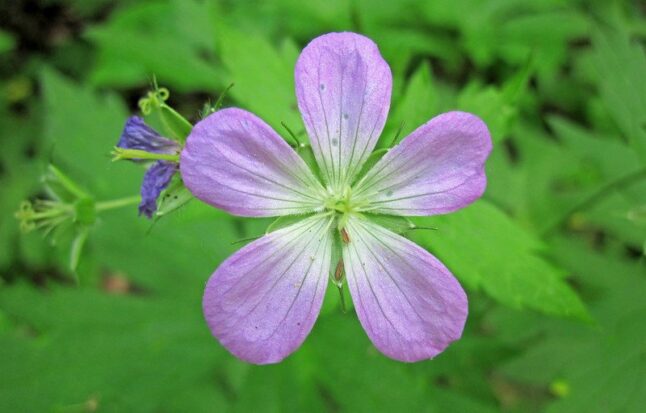
Cranesbill, or wild geranium, is a perennial plant that forms clusters. It blooms an abundance of pale lilac-pink flowers with a white center and faint veins. Blooming from April to June, the wild geranium is perfect for attracting bees, beetles, and butterflies, making it a favorite among gardeners looking to support local wildlife.
Moreover, it thrives in full sun to part shade, making it a versatile option for different parts of your garden.
Pro tips:
- Deadhead spent flowers to encourage more blooms.
- Divide the clumps every 3-4 years in the spring or fall to maintain vigor.
- It can be propagated by seed, but it’s easier to divide established plants.
- Adding cranesbill to your rock or cottage garden can work wonders. Plus, it can be an effective ground cover plant that can help keep pesky weeds at bay.
Main Characteristics:
- USDA Hardiness Zones: 3-8
- Duration: Perennial
- Sun: Full sun to partial shade
- Soil: Well-drained; loam, sand, clay
- Height: 1-2 ft.
- Maintenance: Low; deadhead spent flowers, divide clumps every 3-4 years
- Attracts: Bees, butterflies
- Tolerance: Deer, rabbit, dry soil, drought
Where to find wild geranium:
- American Beauties Native Plants maculatum (Wild Geranium)
- 30 Bare Roots Cranesbill Wild Geranium Organic Plants Maculatum
- Yunakesa Wild Geranium Mature Roots Systems (RFS) Geranium Maculatum (10 Bareroot Plants)
Compass plant (Silphium laciniatum)
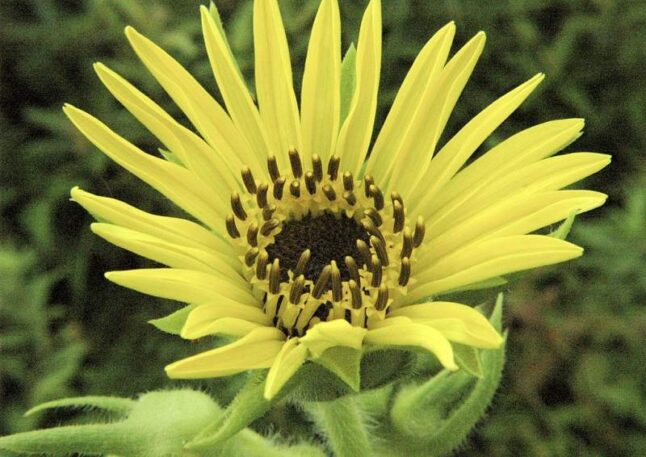
The compass plant, also known by its scientific name Silphium laciniatum, is a sturdy, long-lasting plant that’s native to North American prairies. It gets its name from the way its leaves naturally align themselves in a north-south direction. This clever orientation helps the plant avoid getting too much direct sunlight during the hot midday hours.
Its sunflower-like blooms, which appear from July to September, are a magnet for pollinators, attracting bees, butterflies, and birds with their nectar and seeds. Not to mention, its deep roots, which can reach up to 15 feet into the ground, make it incredibly drought-resistant and help prevent soil erosion.
Pro tips:
- Plant it in a spot where it will get plenty of sunlight. The more, the merrier!
- Don’t overwater it, as it is accustomed to the drier prairie soils.
- Cut back the stems in late winter to make room for new growth.
- Oh, and a word of warning – the compass plant can get quite tall, sometimes reaching up to 9 feet in height, so make sure to plant it at the back of your garden to avoid overshadowing other plants.
Main Characteristics:
- USDA Hardiness Zones: 3-9
- Duration: Perennial
- Sun: Full sun
- Soil: Sandy, loam, clay; it prefers well-drained soil
- Height: 6-9 feet
- Maintenance: Low; cut back stems in late winter
- Attracts: Bees, butterflies, birds
- Tolerance: Drought, deer
Where to find compass plant:
- 1 oz Seeds (Approx 660 Seeds) of Silphium laciniatum, Compass Plant
- 10 Yellow Compass Plant Silphium Laciniatum Prairie Compass plant 4″ Flower (LSL) Seeds
- 10 Seeds Yellow Compass Plant Silphium Laciniatum Prairie Compass plant Flower
FAQ About Native Illinois Flowers
Illinois spans several hardiness zones, from 5a in the northwest corner of the state to 7a in the southernmost tip. Most of the state falls under zones 5b, 6a, and 6b. It’s always a good idea to check a USDA Hardiness Zone map to pinpoint the exact zone for your location since planting appropriately for your zone will help ensure gardening success!
Native plants have evolved alongside the local fauna, forming a symbiotic relationship. For example, they provide food and habitat for native pollinators like bees, butterflies, and birds. These pollinators, in turn, help the plants reproduce by spreading their pollen. It’s a win-win situation!
Besides that, there are also other benefits of native flowers in landscaping, including:
• Low Maintenance: They are well adapted to local soil and climate conditions, requiring less water, fertilizer, and pesticides.
• Prevent Soil Erosion: Their roots help bind the soil together, reducing runoff and erosion.
• Preserve Natural Heritage: Planting native species helps prevent them from being crowded out by non-native species, preserving the region’s natural heritage and maintaining ecological balance.
The state flower of Illinois is the violet. It was chosen as the state flower by schoolchildren and officially designated as such by the Illinois General Assembly in 1908. Several wild violets are found in Illinois, including Common Blue Violet.
Illinois is home to a variety of native flowers in addition to the ones mentioned above. Here are a few more beautiful native blooms you might come across in Illinois:
• Black-eyed Susan (Rudbeckia hirta): A bright yellow flower with a dark brown center, blooming from June to October.
• Prairie Blazing Star (Liatris pycnostachya): Features tall spikes of purple flowers that bloom from July to September.
• Blue False Indigo (Baptisia australis): Features tall spikes of deep blue flowers that bloom in May and June.
Remember, if you’re thinking about adding some of these beauties to your garden, it’s always a good idea to source your plants from a reputable nursery that specializes in Illinois native plants.
Unfortunately, native grasses don’t usually create the uniform, tidy look you want from a home lawn. But the best turfgrass types for Illinois lawns include Kentucky bluegrass, fine fescues, tall fescue, and rough bluegrass. If you’re in Southern Illinois, Zoysiagrass is also a good option.
Whatever grass type you choose, be sure to follow our lawn care guide for Illinois to keep it healthy and green – an excellent backdrop for your native flowers!
Final Thoughts
Planting native Illinois flowers is a wonderful way to add beauty to your garden while also supporting the local ecosystem. Whether you choose the vibrant pale purple coneflower or the showy wild bergamot, you can’t go wrong with any of these native beauties.
Instead of going for exotic plants, choose natives to protect Illinois’s natural heritage. Ready to get planting? If you’re unsure where to start, LawnStarter can connect you with local Illinois landscaping and lawn care pros to guide you. Whether you’re in Chicago, Tinley Park, Joliet, Springfield – or anywhere else in the great state of Illinois – LawnStarter can connect you with passionate lawn care and landscaping pros with helpful advice. So go ahead, get your hands dirty for a good cause!
Main Photo Credit: The Shakespeare Garden in Evanston / Teemu008 from Palatine, Illinois / Wikimedia Commons / CC BY-SA 2.0